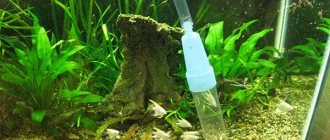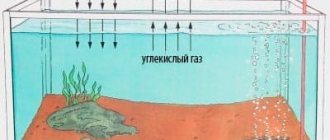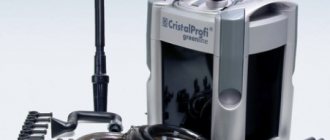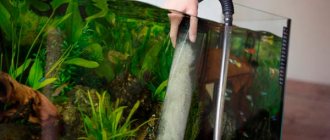Purpose and principle of operation
Animals in an artificial reservoir need a sufficient amount of oxygen. Poor aeration causes the water to quickly become cloudy. This has a detrimental effect on the health and vital activity of the living inhabitants of the container. And the tank begins to look unsightly. Gradually the aquarium turns into a small swamp.
Pumps pumping water are necessary in order to avoid all these unpleasant consequences. They perform the following functions:
- Keeping the tank clean.
- Saturation of aquarium water with oxygen.
- Creating circulation.
Air supply for aquarium animals and plants must be provided constantly, especially at night. This is due to the fact that during the daytime oxygen is released under the influence of light, and at night the process stops. As a result, the reservoir becomes oversaturated with carbon dioxide. Thanks to the pump, oxygen constantly enters the container. You can purchase a filter pump in the form of a foam rubber sponge. In this case, the speed of water purification occurs faster.
A pump should also be purchased in the following cases:
- Reservoir overpopulation.
- Non-standard container shape. The pump must be used in a tank that is too narrow or deep.
- There are no living plants in the artificial pond. The device is also needed in case of too much vegetation.
- If water biofiltration is impaired.
- The container with fish is closed with a lid without holes.
An aquarium pump prevents the appearance of greasy deposits in the upper layers of water. The device mixes the liquid, equalizing the temperature in the tank. The pump is also a decorative element. The resulting bubbles fall in a cascade, simulating a fountain or waterfall.
Types of pumps
Aquarium pumps differ from each other in the following characteristics:
- by type of construction;
- according to the installation method.
Let's take a closer look at the types of pumps.
By design
By design, pumps can be divided into two large groups:
- Membrane devices. An aquarium pump of this type makes virtually no extraneous sounds. Plus, it consumes little energy. But the device cannot be used for large-volume tanks. It has low productivity, and therefore is used in containers with a volume of no more than 150 liters.
- Piston devices. Much more powerful than the first type. The downside is the strong noise during operation and vibration during pumping. This device is used for large aquariums with a volume exceeding 200 liters.
You can purchase the device at any specialized store. There you can also get advice on choosing a device.
By installation type
According to the installation method, aquarium pumps are:
- Submersible or internal. Placed directly in the aquarium water. Fixed with suction cups.
- External. Attaches to the outer wall of the container. Only the device tube is placed inside. Designed for small tanks.
It is also worth choosing an external device if there are fish in the aquarium with demanding conditions. It saves space and does not create discomfort for animals.
What is the pump for?
Its main task is to ensure the normal functioning of the aquarium: pumping and mixing water, supplying oxygen. It is this that creates the pressure necessary for the operation of the external filter. If necessary, it helps to create a current in the water, promotes the operation of the aerator, and slows down the process of contamination of the tank.
There are several varieties of this device:
- internal type;
- external (or external);
- universal model.
Choosing a pump for an aquarium
The aesthetic appearance of the tank can be spoiled by incorrectly selected additional equipment. The noise from the pump and too intense water flow will create discomfort for the animals and plants in the container. To avoid these problems, you should pay special attention to the choice of pump:
- it must correspond to the volume of the artificial reservoir.
- It is worth determining the location of the pump in advance.
- You should pay attention to the power of the device. It is influenced by the volume and number of inhabitants of the container.
- The choice of device is also influenced by the presence of vegetation in the aquarium.
The pump in the aquarium operates around the clock, so it is better to give preference to devices that operate silently. Particular attention should be paid to this fact if the aquarium is installed in the bedroom or children's room.
Popular manufacturers
Aquarium pumps differ from each other in power and performance. Let's look at the most popular models:
- Aquael from a Polish manufacturer. Operating capacity from 500 to 2000 liters per hour. The unit uses motors with energy-saving characteristics. There are O-rings that prevent large loss of efficiency. The pump can also be used as a circulation pump due to the smooth adjustment of the water flow.
- Juwel Eccoflow, made in Germany, is a vane pump. The units are almost silent. The kit includes additional adapters for the filter. Pump performance varies from 300 to 1500 liters per hour depending on the model.
- Aqua Medic is used for salt water containers. Has great power. The manufacturer has equipped some models with a controller that simulates the effect of a breaking wave. The vibration level can be controlled using a magnetic holder.
- Tetra is a submersible water pump. Completely immersed in water and easy to decorate. Has a regulator to control the water flow. Capacity is 300 liters per hour.
- AquaClear also applies to submersible mini pumps. The water circulates, saturating it with oxygen. Water pressure varies from 0.7 to 1.7 meters. Depending on the model, productivity is 480-1500 liters per hour.
- Deltec fully automatic water pump. Used for aquariums, terrariums, florariums. The pump can operate in water with any characteristics. Suitable for containers that regularly receive fertilizer. There are two and four channel pumps equipped with a controller. Channels are set to turn on hourly. The maximum interval between starts is 30 days. Fully submersible or dry models are available. There are devices with a lifting pump; it is activated while the fish are feeding.
- Eheim is a submersible aquarium pump. Used for regular circulation of water flow. It has a power regulator that allows you to adjust the required performance. The device can create the effect of an artificial waterfall. It can be used not only for working in an aquarium, but also for irrigating lawns and artificial ponds in the garden.
Depending on your needs, you can choose a model that is suitable specifically for your aquarium.
Homemade aquarium pump: pros and cons
The main advantages of a homemade device: saving money; if you know how to work with your hands, assembling a pump from available materials will not take much time; the device can be modified according to your wishes and needs of the inhabitants of the aquarium; If desired, the device can be given an aesthetic appearance that matches the decor of the container. The downside can be considered possible errors in work, for example, insufficiently strong sealant or inaccuracy in calculations.
Features of choosing and using pumps for a marine aquarium
Saltwater aquariums usually contain corals and various sponge species as natural water purifiers. Both of them, as well as fish in their natural habitat, are dependent on the current. All life cycles, the availability of food, and the change of seasons for marine inhabitants are associated with the current. Taking this important factor into account, current pumps are installed on tanks containing seawater inhabitants, which also perform the function of cleaning and aeration. The following nuances need to be taken into account: For ten to twelve hours, the pump must be turned off, simulating calm. The volume of pumped water per hour should be approximately fifteen times the volume of the tank. The water flow is directed to the bottom stones. For large containers, it is recommended to purchase two devices.
Assembling a device for your silent pets yourself is not difficult and does not take long, especially for those who know at least a little about the operation of such devices. If you don’t have the skills, you can look for a budget option, but in any case, this device is vital for aquatic life.
How to properly install a pump in an aquarium
Before installing the pump, you should choose a location for the device. It depends on the type of device. The pump can be attached to a wall, container lid or cabinet. Depending on the model, suction cups, brackets, or both are used to secure the pump.
The device should be placed in such a way that it can pump out water and prevent water stagnation. That is, it should be a place with low current. Decorative elements and plants should be located at such a distance that they do not block the operation of the pump.
Attention! The optimal solution is to locate the device near the water heater. This will allow you to simultaneously heat the liquid and distribute it evenly in the aquarium.
The pump installation principle depends on the type of pump:
- The selected submersible device must be installed with it turned off. It is immersed in water by 2-4 cm, but it should not touch the bottom of the container. One end of the air hose is inserted into the device, the other is brought out. The flow intensity should be set to average.
- An external type aquarium pump for pumping water is one of the more bulky devices. And it costs more than the first option. The pump is installed on a special stand, which will correspond to the size of the aquarium paired with the pump. The furniture should contain additional shelves where accessories for the pump can be placed.
The device includes two tubes: the long one is for taking in water, the short one is for releasing it. The aquarium is filled by gravity. Air from the tubes should not interfere with the operation of the device.
What are there
In real reservoirs, oxygen is supplied by wind flow and water vibrations. In a closed container, aquarium pumps are responsible for this process.
- By design. There are piston and diaphragm options.
- By installation. There are submersible and external.
Piston devices will last a long time, and they are more powerful than membrane ones. Their disadvantage is that they make a lot of noise and vibrate. Such devices should be used for aquariums with a volume larger than 200 liters. Diaphragm pumps operate silently and consume minimal energy. They have one drawback - they are suitable for containers up to 150 liters.
Equipment that is submerged under water is secured using clamps or suction cups. The external model is installed behind the aquarium. It is designed for small containers and is also suitable for growing demanding fish. You can easily secure the aquarium pump with your own hands.











